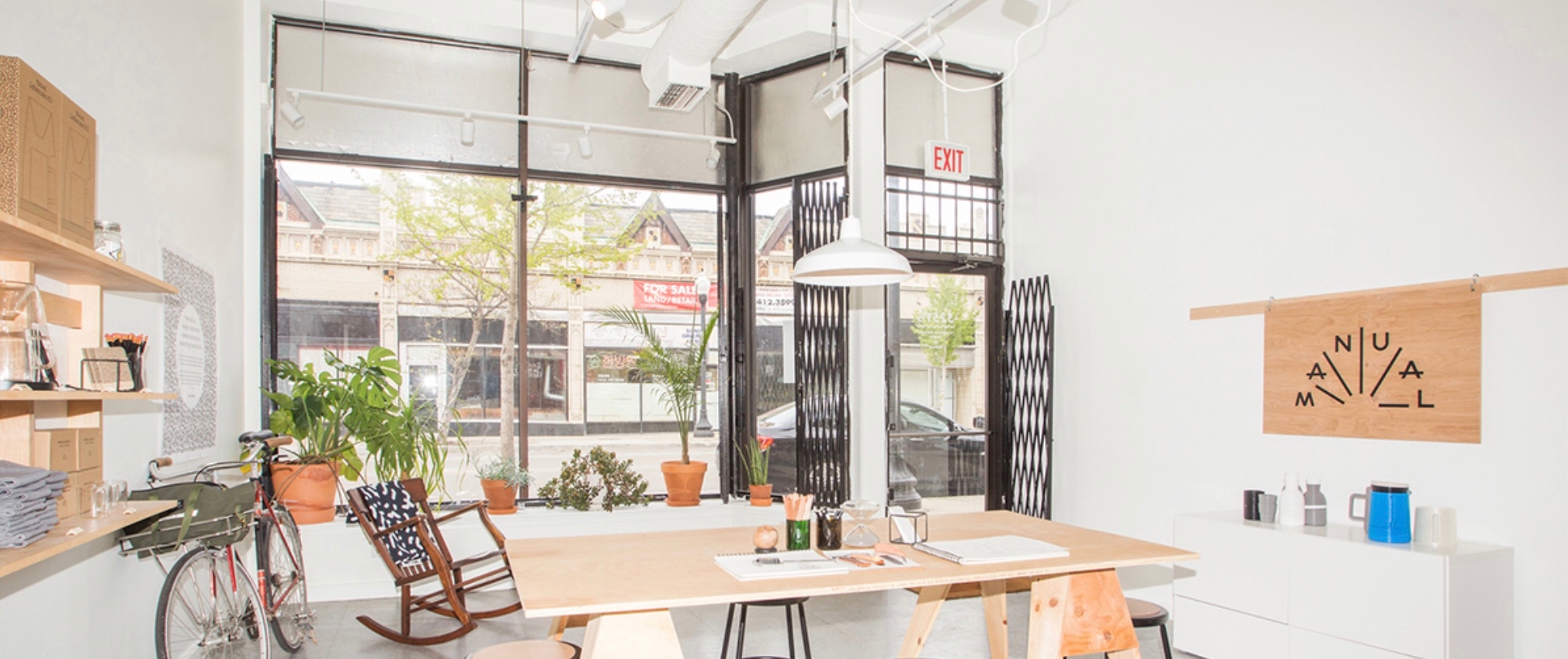Doggerel Ι June 29, 2017
For Microsoft, illustrator and industrial designer Craighton Berman created a primer on artificial intelligence. Over a few dozen pages, his breezy little booklet used talking dogs and clunky retro-robots to explain the basics of a technology that’s fueled sci-fi dystopias and utopian TED talks alike. It was a zine in the humble indie bookstore tradition, but it premiered at the World Economic Forum, an event where slick slide decks far outnumber spine-stapled pocket volumes.
Whether he’s drawing for neighbors in Chicago or global leaders at Davos, zines are a favorite for Berman. “I love that paginated idea, spreading across something,” he said.
Beyond Microsoft, Berman works with a handful of international brands, like Airbnb and HP, always retaining the sense of off-center, intimate handicraft.
The storefront studio
His clients may be global, but Berman is hyperlocal. Each morning, with his bichon/terrier mix, Norman, at his side, he walks his kids to school just a few blocks from his home on Chicago’s northwest side, then to his storefront design studio / store / event space another short jaunt away.
The studio is located in the North Park neighborhood, outside the heart of Chicago’s gentrifying creative-class corridors. Long a magnet for immigrants from different parts of the world, the area houses a substantial refugee population. Berman’s neighbors are a Korean tailor, an acupuncturist, an Assyrian Christian Church, and more than a few vacant storefronts.
The main-drag location affords the opportunity to “step right out into a neighborhood and feel like you’re part of something,” he said. It also allows him to give back to the local community by demystifying design. Neighbors can learn about his process by stopping by to ask questions, attending a public event, or simply glancing in through the window.
Sketching to suspend disbelief
Berman’s illustrations (which include a freehand drawing of the 50 states that has garnered 19 million views on YouTube) have the easy vibe of a sketchbook: flowing, casually hurried, and above all, conversational.
But most of the topics he’s illustrating aren’t lighthearted cocktail fodder. For tech clients his commissions deal with cancer research, quantum computing, and smart power grids. His depictions make these issues more relatable.
“There’s something about the casual nature of someone sketching an idea out for you. You’re willing to suspend your disbelief for a second and just understand the concept at a high level,” he said.
“We’re in a much more visual time. Everybody’s got a camera in their pocket. Everybody’s taking pictures all the time. That’s mixed with [the fact that] everybody’s got access to a lot more information. There’s a craving to understand it all, and you just can’t. So I think that’s where the explainer sketchbook approach comes in.”
The globalized economies Berman sometimes depicts have generated so much complexity that there’s a thirst for simple pen-on-paper, made by a guy sitting at his desk with his dog at his feet. People want things that are handmade. Or hand-drawn.
His drawings are rife with offbeat details that humanize grand scientific inquiry. Piles of junk food accumulate on the desk of an app developer, signifying the all-nighter deadline crunch. A donut-munching man using a smartphone that can decipher the pastry’s nutritional value has crumbs tumbling off his chin.
Food focus
Food is an important theme in much of Berman’s work — most obviously in his kitchenware line, Manual. Manual shares the formal economy of his animation and illustration, but this time with a Zen-like simplicity. To date, he’s made a coffee maker, bar blade, cocktail set, and tea maker, as well as a salt-and-pepper set that’s a graceful two-line poem of minimal geometry.
Manual is an “exercise in focusing for me,” Berman said. “The industrial designer in me keeps wanting to explore and try new materials, but the entrepreneur in me says, ‘No — now that you know how glasswork works, you should be doing that.’ Previously I would jump from a light to a stool to this to that. It’s really fun to do that, but it’s hard to build a brand.”
Moving forward on this strict and steady path, Berman next wants to do a bread-serving kit: cutlery, cutting boards, breadbox. But then maybe some furniture, he says… as long as it’s for a restaurant.
